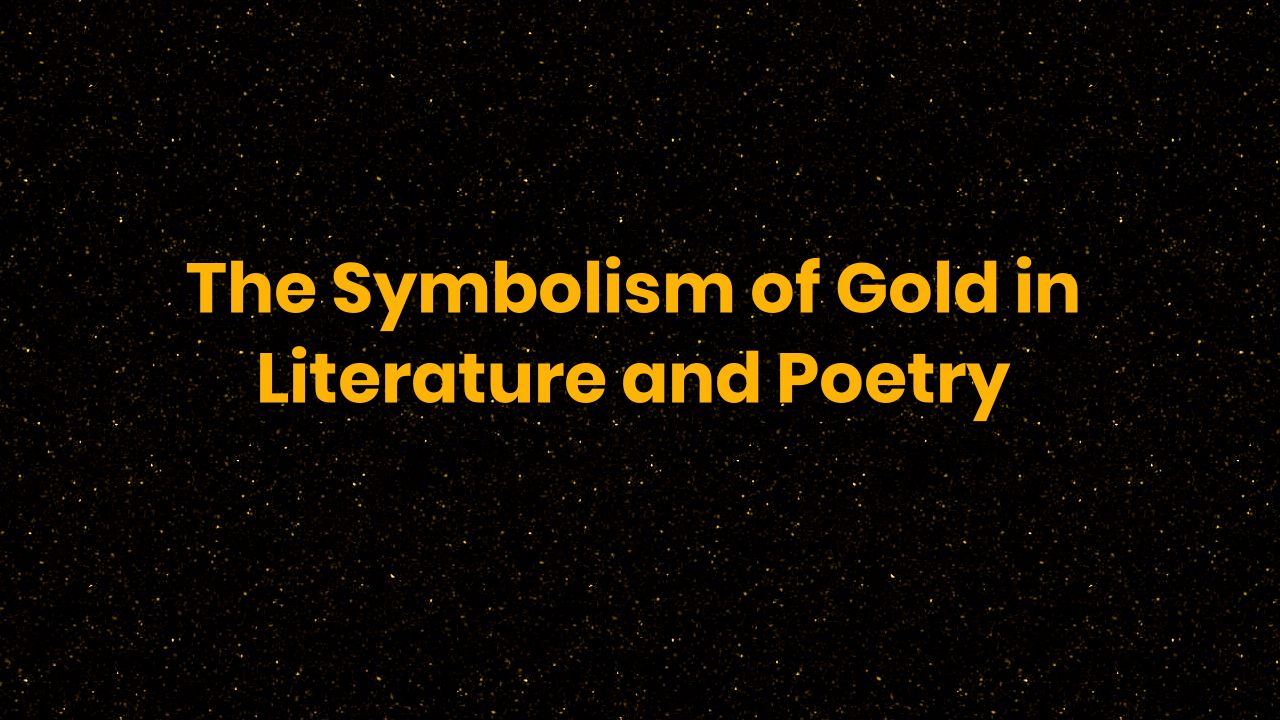
Table of Contents
Symbolism of Gold in Literature and Poetry
Gold has held an enduring fascination for humanity, and its symbolic power continues to captivate artists and writers. Throughout literature and poetry, gold carries multifaceted meanings that reflect our deepest human desires and aspirations. As a precious metal, gold has been associated with wealth, luxury, power, and status. It has also been used symbolically in religious and spiritual contexts to represent purity, perfection, and divinity. Furthermore, gold is often associated with eternity and immortality, as well as with the destructive consequences of greed and desire. In both historical and mythological narratives, gold has played a prominent role, and it remains relevant today in contemporary literature and poetry.
Gold as a metaphor for wealth and luxury
One of the most common uses of gold in literature and poetry is as a metaphor for wealth and luxury. The image of gold as a symbol of opulence and extravagance has been used throughout history, from the lavish palaces of kings and emperors to the glittering jewelry worn by the wealthy elite. In F. Scott Fitzgerald’s classic novel, The Great Gatsby, the protagonist Jay Gatsby is described as having a “house twinkling like the World’s Fair” and being “covered with a gleaming coat of gold.” This image of gold represents not only Gatsby’s immense wealth but also the allure of the American Dream itself.
- Examples:
- The gold breastplate and helmet in Homer’s Iliad
- The Golden Fleece in Greek mythology
- King Midas’ Golden Touch
Gold as a symbol of power and status
Beyond its association with wealth and luxury, gold is also often used as a symbol of power and status. Gold, as a rare and valuable metal, has historically been associated with royalty, and it has been used to create exquisite crowns, scepters, and other regalia. In William Shakespeare’s play, Antony and Cleopatra, Cleopatra is depicted as a queen of immense wealth and beauty, and she is described as being adorned with golden jewelry and clothing. This golden imagery reinforces her regal status and authority in ancient Egypt.
- Examples:
- The golden crowns and scepters of kings and queens
- The Olympic gold medal
- The Gold Star in the United States military
The use of gold in religious and spiritual contexts
Gold’s physical properties, its luster, brightness, and indestructibility, have also made it a popular symbol in religious and spiritual contexts. In many cultures, gold is used to represent the divine, the pure, and the perfect. In the Hindu religion, gold is associated with Lakshmi, the goddess of wealth and prosperity. In Christian art, gold is often used to depict halos, representing the divine light of God. The use of gold in spiritual contexts serves to elevate human desire towards the sacred and the eternal.
- Examples:
- The golden calf in the Old Testament
- The Buddha’s golden body in Buddhist iconography
- The golden menorah in Jewish scripture
Gold as a representation of purity and perfection
As a metal that does not tarnish or corrode, gold has come to represent purity and perfection. Gold represents that which is unchanging and unadulterated, and it has been used to describe beauty, goodness, and truth. In Samuel Taylor Coleridge’s poem “Kubla Khan,” gold is described as “a sunny pleasure-dome with caves of ice” that symbolizes the perfect balance of contrasts in nature.
- Examples:
- The golden ratio in mathematics and aesthetics
- The golden sun in many cultures represents light and warmth
- The golden apples of the Hesperides in Greek mythology
Gold as a symbol of eternity and immortality
Perhaps one of the most profound symbolic meanings of gold is its association with eternity and immortality. Gold reflects the eternal nature of the human soul, and it has been used to represent the unceasing passage of time. In William Blake’s poem “The Sick Rose,” gold is portrayed as a symbol of the unchanging nature of love and romance, which continues to exist even as the world around it changes and fades away.
- Examples:
- The Golden Gate in Jerusalem, representing entry to the eternal world
- The Golden Stairs in Dante’s Purgatorio, symbolizing the path to Heaven
- The golden threads of the Fates in Greek mythology, representing the unchanging destiny of human beings
The contrast between the beauty of gold and its destructive consequences
While gold’s symbolism is often associated with beauty and purity, it also carries darker connotations. Gold’s lustre often hides the destructive consequences of greed and desire, and its beauty can be deceptive. In John Steinbeck’s novel, The Pearl, the protagonist Kino becomes obsessed with a valuable pearl, believing it will provide him with wealth and happiness. However, his obsession leads to violence and tragedy, demonstrating the dangerous consequences of following one’s desires blindly.
- Examples:
- The portrayal of greed through the desire for gold in many fairy tales
- The gold rush in America in the 19th century resulted in environmental degradation and exploitation of laborers
- The theft and plundering of gold throughout history as a result of colonization
The importance of gold in historical and mythological narratives
Gold has played a significant role in the history and mythologies of cultures around the world. It has been a source of wealth, power, and influence, and it has also been the subject of legends and fables. In Norse mythology, the god Odin possesses a golden ring that multiplies itself every ninth day, symbolizing the infinite potential of knowledge and wisdom. Additionally, the conquistador Hernán Cortés is said to have covetously asked about the gold of the Aztecs, beginning the onslaught of colonization on the Americas.
- Examples:
- The gold standard in economics and trade
- The plundering of the Roman Empire’s golden treasures by the barbarians
- The glittering treasures which are described in Howard Carter’s account of the discovery of King Tutankhamun’s tomb
The role of gold in contemporary literature and poetry
Gold continues to serve as a powerful symbol in contemporary literature and poetry. Its symbolic meaning has evolved and expanded, reflecting the concerns of the modern world. In the poet Emily Dickinson’s poem “My life closed twice before its close,” gold is portrayed as a symbol of spiritual attainment and transcendence. Similarly, in Yaa Gyasi’s novel, Homegoing, the character Kojo is described as being “as bright as gold before it is refined,” a symbolic representation of the transformational journey that African-Americans have endured in pursuit of self-realization.
- Examples:
- Gold in the Harry Potter series as described as being the metal in death and Dumbledore’s eyes
- The Golden Notebook by Doris Lessing contains various colors of notebooks, with the golden one serving as the most important
- The poem “Nothing Gold Can Stay” by Robert Frost portrays the fleeting nature of beauty and youth
Conclusion: the enduring appeal and significance of gold symbolism in the arts
Through its multifaceted symbolic meanings, gold has remained an enduring and significant element in literature and poetry. Whether it is used to represent wealth, power, divinity, or immortality, gold reflects our deepest human desires and aspirations. Its image has been used to explore the complexities of human nature, from our highest ideals to our darkest temptations. Thus, gold remains a powerful and evocative symbol in the arts, one that will continue to captivate and inspire writers, poets, and artists for generations to come.






Comments